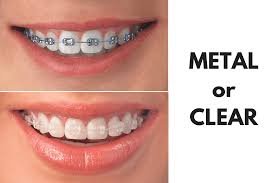When it comes to orthodontic treatment, the decision between clear and metal braces is one of the most common dilemmas faced by patients. Both types of braces have their own advantages and disadvantages, making it crucial to weigh your options carefully. In this comprehensive guide, we’ll delve into the key aspects of clear and metal braces, including cost, aesthetics, comfort, effectiveness, and durability, to help you make an informed decision.
1. Overview of Clear and Metal Braces
Metal Braces Metal braces, also known as traditional braces, consist of high-grade stainless steel brackets and wires that are fixed to the teeth. They have been the standard in orthodontics for decades due to their reliability and effectiveness.
Clear Braces Clear braces, on the other hand, are made from ceramic or composite materials that blend with the natural color of the teeth, making them less noticeable. They work similarly to metal braces but offer a more discreet appearance.

2. Cost Comparison
The cost of orthodontic treatment varies depending on the complexity of the case, the provider’s expertise, and the region. However, there are some general differences between clear and metal braces:
Metal Braces
- Average Cost: $3,000 to $7,000
- Insurance Coverage: Most insurance plans cover a portion of the cost for metal braces.
- Additional Costs: Minimal maintenance costs; durable and less prone to breakage.
Clear Braces
- Average Cost: $4,000 to $8,500
- Insurance Coverage: Some insurance plans may cover clear braces, but often to a lesser extent than metal braces.
- Additional Costs: Higher maintenance costs due to the potential for brackets to stain or break.
3. Aesthetic Appeal
Metal Braces
- Visibility: Highly noticeable due to their metallic color.
- Customizability: Patients can choose colored elastics for a personalized look.
- Perception: Often associated with younger patients, such as teenagers.
Clear Braces
- Visibility: Blend with the teeth, making them less noticeable.
- Customizability: Limited options for personalization.
- Perception: Preferred by adults and professionals seeking discreet treatment.

4. Comfort and Maintenance
Metal Braces
- Comfort: May cause initial discomfort as the brackets and wires can irritate the inner cheeks and lips.
- Maintenance: Easier to clean; less prone to discoloration or staining.
- Durability: Highly durable and resistant to breakage.
Clear Braces
- Comfort: Similar level of discomfort as metal braces initially, but ceramic brackets can be larger, causing potential irritation.
- Maintenance: Require diligent cleaning to prevent staining and discoloration of brackets and elastics.
- Durability: More fragile than metal braces; brackets may chip or crack.
5. Effectiveness in Treatment
Both clear and metal braces are effective in treating a wide range of orthodontic issues, including overcrowding, gaps, overbites, underbites, and misaligned teeth. However, there are some differences in their performance:
Metal Braces
- Strength: More robust and capable of handling complex cases.
- Speed: Often work faster due to their durability and lower friction.
- Suitability: Ideal for severe misalignments and younger patients.
Clear Braces
- Strength: Slightly less robust; not recommended for severe cases.
- Speed: May take slightly longer to achieve results due to the fragility of the brackets.
- Suitability: Best for mild to moderate cases and adults prioritizing aesthetics.
6. Longevity and Durability
Metal Braces
- Resistant to wear and tear.
- Less likely to require repairs.
- Can withstand greater forces during treatment.
- More prone to wear and tear.
- May require occasional repairs or replacements.
- Brackets can chip, and elastics can discolor over time.
Clear Braces
7. Pros and Cons
Metal Braces
- Pros:
- Cost-effective.
- Highly durable.
- Suitable for all cases, including severe misalignments.
- Minimal maintenance required.
- Cons:
- Highly visible.
- Perceived as less aesthetically pleasing.
Clear Braces
- Pros:
- Discreet and aesthetically appealing.
- Suitable for adults and professionals.
- Effective for mild to moderate orthodontic issues.
- Cons:
- Higher cost.
- More fragile and prone to staining.
- May take longer to achieve results.
8. Who Should Choose Metal Braces?
Metal braces are an excellent choice for:
- Young patients who are less concerned about aesthetics.
- Individuals with severe orthodontic issues.
- Budget-conscious patients seeking an effective solution.
- Those who want durable and low-maintenance braces.
9. Who Should Choose Clear Braces?
Clear braces are ideal for:
- Adults and professionals prioritizing discreet treatment.
- Patients with mild to moderate orthodontic issues.
- Those willing to invest in higher costs for aesthetic benefits.
- Individuals committed to maintaining proper oral hygiene.
10. Alternatives to Clear and Metal Braces
If neither clear nor metal braces seem like the right fit, there are alternative options available:
- Invisalign: Clear aligners that are removable and virtually invisible. They are best suited for mild to moderate cases.
- Lingual Braces: Fixed to the backside of the teeth, making them completely hidden. However, they can be more expensive and less comfortable.
- Self-Ligating Braces: Available in both metal and clear options, these braces use clips instead of elastics, reducing friction and potentially shortening treatment time.
Conclusion
Choosing between clear and metal braces involves considering your budget, aesthetic preferences, and orthodontic needs. While metal braces are cost-effective, durable, and suitable for all cases, clear braces offer a discreet alternative for those prioritizing appearance. Consulting with an orthodontist is essential to determine the best option for your individual needs. By understanding the pros and cons of each type, you can make a confident and informed decision on your journey to a beautiful smile.






